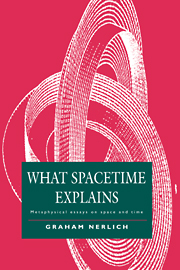Part One - Ontology and methodology in relativity
Published online by Cambridge University Press: 19 October 2009
Summary
The essays in this part are about issues which arise within special relativity in one way or another. Each of them argues that the special theory is a more structured, ontologically richer and deeper theory than many philosophers have taken it to be. Several of the essays raise questions of methodology for the metaphysics of spacetime. All of them sustain and explore the theory that spacetime performs a unique and crucial role in explanation which earns it a secure place in our ontology.
From rather early in its development it was realized by Robb (1914) that the full metric structure of spacetime could be built on surprisingly slender foundations. Robb laid down a few axioms on a relation which he called after. This idea failed to seize general attention for a number of years. It was taken up subsequently by a number of writers, notably, for our purposes, Zeeman (1964), Hawking and Ellis (1973) and Winnie (1977). (A compact, accessible and elegant account of this may be found in Lucas and Hodgson (1990), chapter 3.) The key relation was now called causality by all these writers and is now thoroughly established in the literature under that name. This lends colour to the idea that, somehow or other, a notable reductive victory has been achieved: the geometry of spacetime has been dethroned from its status as an abstract structure within which material structures are contained. The only structure we need to be concerned with is fully physical and unpuzzling. It is causality.
A recurring theme among the essays of this part is that nothing of the kind has occurred. I must emphasise that I don't dispute the main substance of the work of Robb, Zeeman and the others.
- Type
- Chapter
- Information
- What Spacetime ExplainsMetaphysical Essays on Space and Time, pp. 11 - 16Publisher: Cambridge University PressPrint publication year: 1994



